|
| |
Back to Private
Aircraft
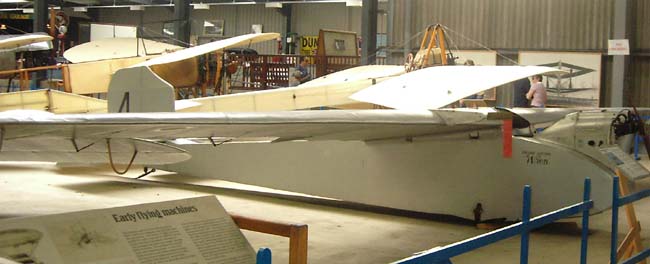 |
The English Electric Wren was built by
English electric in Lancashire as an experimental aircraft for the
1923 light aeroplane trials at Lympne, though a prototype had been
built in 1921. It was powered by a minute 398cc ABC engine. It is a
single seater, 24 feet 3 inches long and with wing span of 37 feet.
One look at it will tell you why it didn't catch on. A few more
horsepower would have helped a lot. Not surprisingly, it could only
manage 50mph. Maximum weight was 422lb.
This one is kept in airworthy condition by the
Shuttleworth Trust at Old Warden.
Photograph by Ivy in April 2005. |
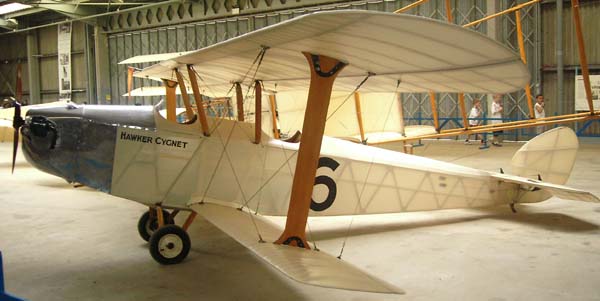 |
The Hawker Cygnet is noteworthy as being the
first design by legendary Hawker designer Sidney Camm. It was built
for the 1924 light aeroplane trials at Lympne, and is powered by a
30hp ABC Scorpion engine. Only two were built. Top speed was 65mph,
creditable on this tiny engine. It is a two seater (just about), 20
feet 3 inches long, with a wing span of 28 feet and maximum weight
of 780lb (though how it could ever get airborne at that weight on
only 30hp is a mystery).
This one is a replica, built in 1992 and kept
in airworthy condition at the Shuttleworth Collection, Old Warden.
Photograph by Ivy in April 2005. |
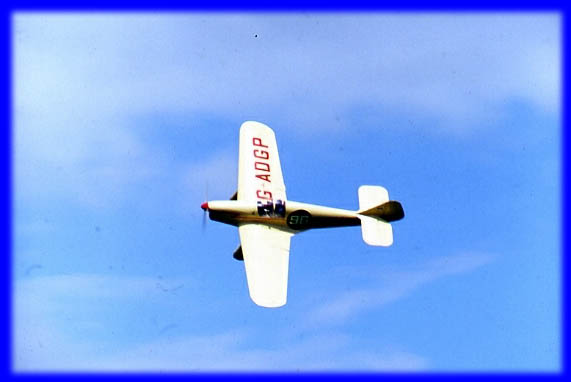 |
The Miles M2L Hawk Speed Six was
an evolutionary development of the Miles M2 Hawk, the second design
of F.G. Miles, which first flew from Woodley in March 1933. Miles
specialised in elegant, fast, sleek aircraft, and the Hawk Speed Six
(so called after its DH Gipsy Six engine) was specially built for
racing. Top speed was 185mph. It was a regular competitor for many
years in Kings Cup air races. A single seater, it is 24 feet long,
with a wing span of 33 feet. Particularly noteworthy is the wide
track undercarriage and the flaps, both unusual features for the
time and greatly assisting controllability at low speeds and on the
ground. Only three Hawk Speed Sixes were
made, including this one, pictured at Old Warden in April 1981. |
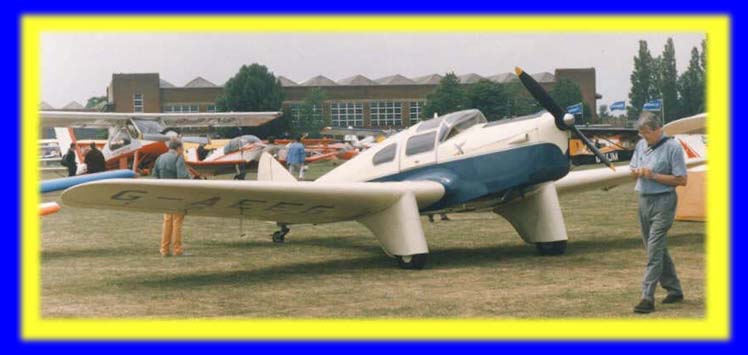 |
The Miles M3A Falcon was a three seat
development of the Miles Hawk concept, with an enclosed cabin for
added comfort. it first flew in 1934. About 40 were built. Most were
powered by a 130hp DH Gipsy Major engine, though a few had the more
powerful 200hp Gipsy Six. it is only slightly larger than the Hawk
Speed Six, being 25 feet long with a wing span of 35 feet. Top speed
is a more sedate 145mph, and range 615miles.
This one was at Cranfield, date uncertain. The
strange shape of cockpit windshield is characteristic. |
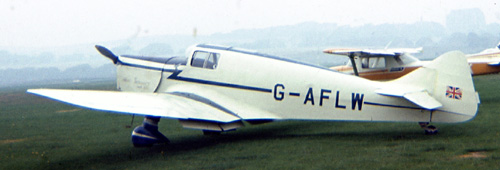 |
The Miles M17 Monarch was an update of the
Falcon, also a three seater, powered by the same 130hp DH Gipsy
Major. It is larger again than the Falcon, 26 feet long with a 35
foot 7 inch span. Its cruising speed is 140mph and range is 910
miles. Gross weight is 2,150lb. It first flew in February 1938. Only
11 were built before the war directed all Miles production towards
Magisters instead.
Shoreham, August 1975 |
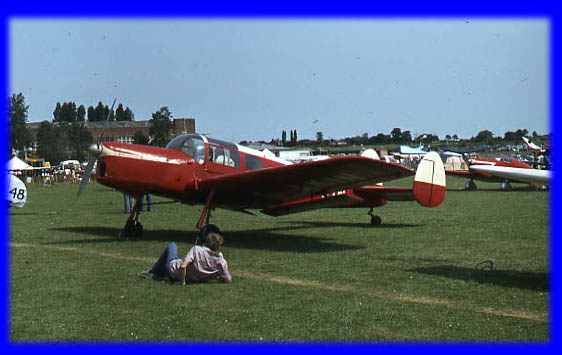 |
The Miles M38 Messenger was designed during
the second world war as a light liaison aircraft. It is a three
seater with superb slow flying and safe handling characteristics.
Its three tails give superb stability, and the unusual arrangement
of flaps (being non-retractable, mounted behind and slightly below
the wing) improve slow flying characteristics. Normal engines were
either the 155hp Blackburn Cirrus or the 145hp DH Gipsy Major,
giving a top speed between 115 and 135 mph and range of 460 miles.
It is 24 feet long with a wing span of 36 feet 2 inches and gross
weight of 2,400lb. In all, 21 were built for the RAF and 72 more
were built as civil aircraft after the war.
This very smart Messenger was at Cranfield in
July 1983. |
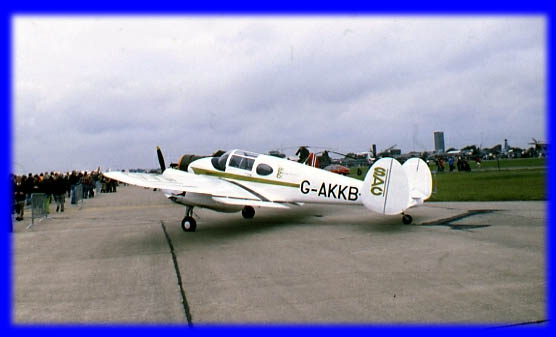 |
The Miles M65 Gemini was a twin-tail, twin-engined,
retractable undercarriage, four seat touring aircraft developed
after the war from the Messenger. It first flew in October 1945.
Geminis were fitted with a variety of engines, mostly 155hp
Blackburn Cirrus or 145hp DH Gipsy Major. Top speed was typically
140mph, range 820 miles. It is 22 feet 2 inches long (shorter than
the Messenger because it doesn't have the engine in the nose), with
a wing span of 36 feet 2 inches. About 130 were built before the
Miles company ceased operations. (My
records tell me that this picture was taken at Wroughton in June
1987, but it doesn't look like it!) |
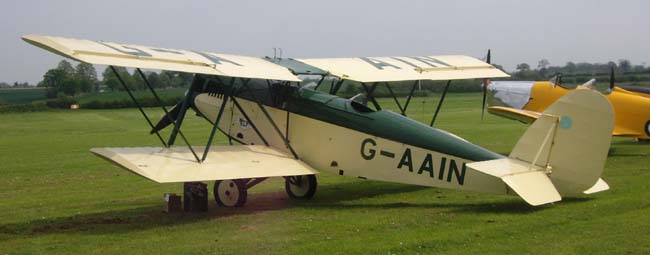 |
The Parnall Elf is an early inter-war design,
having first flown in 1928. It was a two seat biplane powered by an
ADC Hermes engine (note the crankshaft at the bottom and the
cylinders above). Although a fun touring aircraft, with a cruising
speed of 100mph and range of 400 miles, it did not catch on; only
three were made. Length is 22 feet 10 inches, and wing span 31 feet
3 inches (upper wing). This one is kept
in flying condition by the Shuttleworth Trust at Old Warden, where
it was pictured in April 2005. |
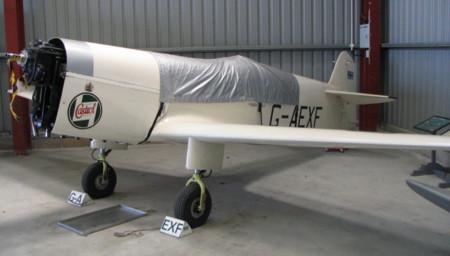 |
Australian designer Edgar Percival designed
the Mew Gull in 1934 as a purpose-built racing aircraft. Six were
built, including one used by Percival himself to win several air
races. The most famous, however, was this one: a Type E2, with a
200hp Gipsy Six engine. It was flown by legendary test pilot Alex
Henshaw to success in several races at speeds up to 236mph,
astounding for those days. Then Henshaw flew it to South Africa and
back in February 1939, it having been specially modified for the
purpose with long-range fuel tanks and cleared for a gross weight of
2,350lb. He accomplished the round trip in 4 days, 10 hours and 16
minutes, an amazing feat of endurance. It is 20 feet 3 inches ling,
with a wing span of 24 feet. It is still airworthy. Alex Henshaw
survived until 2007. This picture shows
the Mew Gull undergoing maintenance at Breighton, June 2007. |
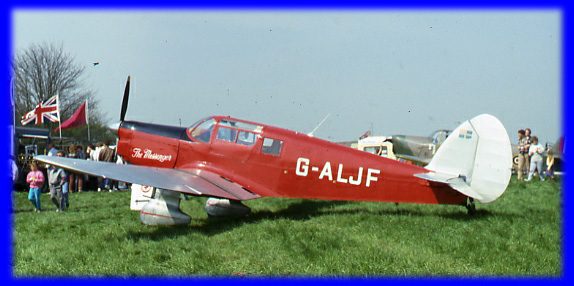 |
The Percival Proctor was built for the RAF
during the second world war as a three seat light liaison and
communications aircraft, developed from Edgar Percival's earlier
Vega Gull design. It first flew in October 1939. 1,247 were built in
total, including 154 built specifically for civil use after the war.
Many ex-military aircraft were also converted to civil use. Powered
by a 210hp DH Gipsy Queen engine, the Proctor had a top speed of
165mph and range of 600 miles. It is 28 feet 2 inches long, with a
wing span of 39 feet 6 inches. Gross weight is 3,500lb.
This one was at Badminton in April 1988. |
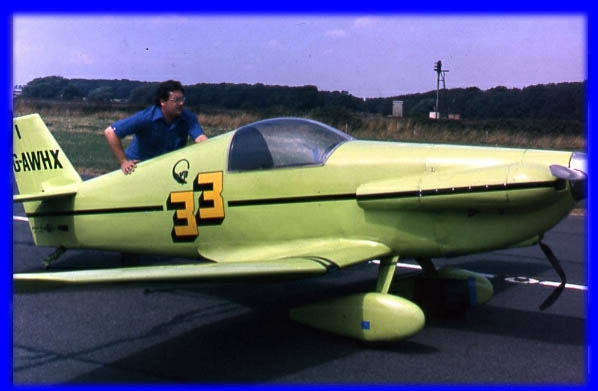 |
The Rollason Beta was designed specifically
for `Formula 1' air racing. A light, wooden design powered by a 90hp
Continental engine, it has a top speed of 185mph and gross weight of
850lb. Like all F1 aircraft it is very small, being 16 feet 8 inches
long with a wing span of 20 feet 5 inches. Only four were made by
Rollason, though some plans have also been sold to home builders.
This one was being pushed to the starting line
for an air race at Teesside in 1976. |
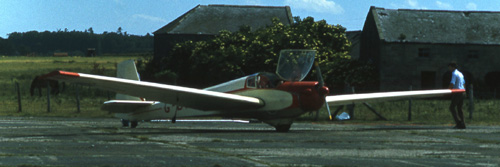 |
The Slingsby T-61 Motorfalke is a
license-built version of the Scheibe SF25 Falke. It is powered,
after a fashion, by a Stark Stamo MS1500 engine. About 20 were built
from 1970, plus around 40 in the late 1970s for the Air Training
Corps as the Venture T.1.
This one was at Milfield in June 1976. |
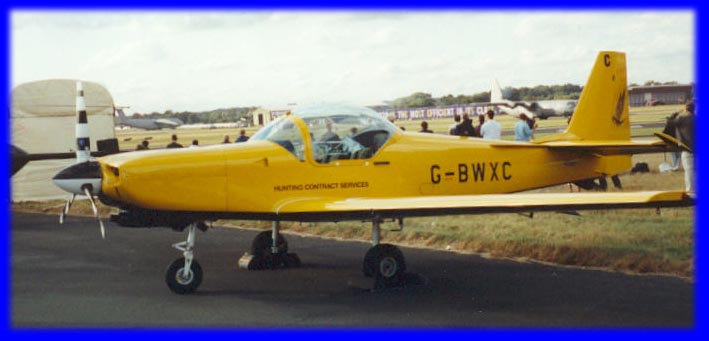 |
The Slingsby T.67 Firefly is a development by
the British Slingsby company of the Fournier RF6B, designed by French
designer Rene Fournier, which first flew in March 1974. The
T67 is largely made of fibreglass, and is powered by a 160hp
Lycoming O-320 engine, giving a top speed of 150mph and range of 650
miles. It is a fully aerobatic two seater, and (with a more
powerful 195hp engine) has been adopted as a primary trainer by many
air forces, including the USAF, who operate it as the T-3A. Length
is 24 feet, wing span 34 feet 9 inches, and gross weight 1,900lb.
Roughly 250 have been built to date (up to
October 2005). This one was at Fairford in July 2005. |
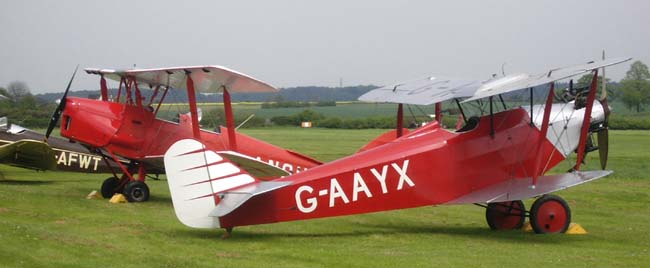 |
The Southern Martlet was one of the first
designs by F.G. Miles (see above for more of his designs). Based
loosely on the aearly post-war Avro Baby, it was fitted with a
variety of radial or inline engines ranging from 80 to 120hp. These
gave top speeds ranging from 110 to 130mph, all having a range just
short of 300 miles. It is a single seater, and is fairly small: only
20 feet 3 inches long and with a wing span of 23 feet 6 inches. Only
five were ever completed, all being considerably different.
This one, powered by an Armstrong Siddeley Genet
radial engine, is kept airworthy by the Shuttleworth Collection at
Old Warden, where it was pictured in April 2005. |
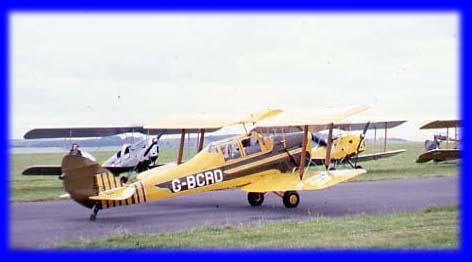 |
The bizarrely named Thruxton Jackaroo is
basically a Tiger Moth, with the fuselage widened to seat four
people in two pairs, and fuly enclosed with a canopy. The resulting
machine, still powered by the original DH Gipsy Major engine and
having a gross weight of 2,180lb, cruised at a sedate 90mph but was
a useful aerial workhorse. Nineteen conversions were made in total,
almost all flying from Thruxton airfield in Hampshire.
This one was at the De Havilland Moth Club 50th
anniversary rally at Sunderland in the late 1970s. |
|
|
The Wallis WA116 autogyro was designed by
Wing Commander Ken Wallis of Reymerston Hall, Norfolk. The prototype
first flew in August 1961. Shouldn't it
be on the helicopters page? No - a helicopter has a powered rotor
which provides both lift and thrust. An autogyro has thrust provided
by a normal engine driving a propeller (there's no reason why it
couldn't be a jet either, apart from speed limitations which would
negate a jet's principle advantage). Lift is provided by a
freewheeling rotor, driven by the forward motion of the machine (in
a helicopter, air flows downwards through the rotor, driven by its
rotation; in an autogyro, air flows upwards through the rotor,
driving it). This means autogyros are a lot simpler than helicopters
- rotor head design is simpler, and there is no need for a complex
(and sometimes dangerous!) anti-torque rotor at the rear.
Wing Commander Wallis built 19 autogyros of
varying types, and at one time held the majority of records for
autogyros such as speed and distance flown. Almost all were single
seaters. The one pictured famously starred in the James Bond film
`you only live twice' as Little Nellie, and was fitted with various
rockets and guns for the purpose.
Autogyros' reputations were unfairly tarnished
after a Wallis autogyro crashed at the Farnborough air show in 1970,
due to the pilot inadvertently pulling negative G - a manoeuvre
strictly outside the bounds of any rotary winged aircraft before the
days of elastomeric bearingless rotors.
The WA-116 is only 11 feet long, with a rotor
diameter of 20 feet 4 inches, and maximum weight 550lb. The top
picture was taken at Reymerston Hall in July 1976; he lower picture
shows Little Nellie in flight during an air display at Old Warden,
date uncertain. |





|